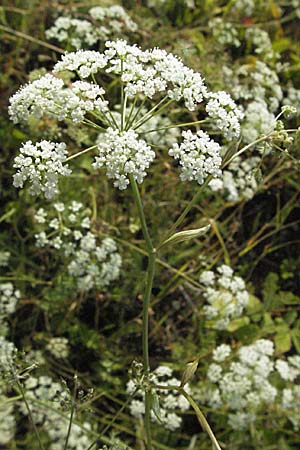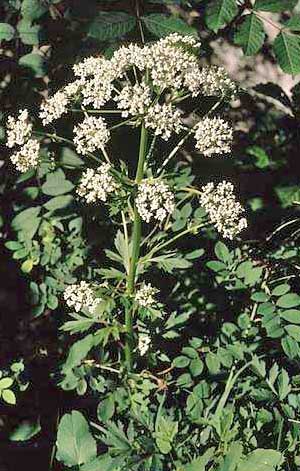Contents:
Common Names | Parts Usually Used | Plant(s) & Culture | Where Found | Medicinal Properties
Legends, Myths and Stories | Uses | Formulas or Dosages | Bibliography
Scientific Names

- Pimpinella saxifraga L.
- Pimpinella magna L.
- Primrose family
Common Names
Pimpinella magna:
- Greater pimpinella
- False pimpernel
- Pimpinella
Pimpinella saxifraga:
- Burnet saxifrage
- European burnet saxifrage
- Pimpinella
- Saxifrage
- Small burnet saxifrage
- Small pimpernel
- Small saxifrage
Parts Usually Used
Rootstock for both
Back to Top

Description of Plant(s) and Culture
Pimpinella magna:
Greater pimpernel is a European perennial plant; reaches a height of 3 feet, the stem bears alternate, odd-pinnate leaves on long petioles dilated at the base. The leaflets are ovate and coarsely toothed, the terminal leaflet more or less 3-lobed. The small, purple or bluish flowers grow in compound umbels from June to September.
Pimpinella saxifraga:
Burnet saxifrage is a European perennial plant; a gnarled, twisted rootstock produces a round, finely grooved, branched stem with alternate, pinnate leaves. The leaflets are variable in shape, ranging from ovate to oblong-lanceolate, and from coarsely toothed to ternately incised. White or yellow-white flowers grow in compound umbels from July to October.
Another variety: Pimpinella anisum is reported on elsewhere as anise.
Back to Top
Where Found
Pimpinella magna:
Grows along the edges of woods, in marshy meadows, and in other wet places.
Pimpinella saxifraga:
Found on slopes and pastures, among bushes, and along the edges of woods, shorelines, and roadsides.
Back to Top
Medicinal Properties
Pimpinella magna:
Antispasmodic, astringent, carminative, diaphoretic, diuretic
Pimpinella saxifraga:
Antispasmodic, astringent, carminative, diaphoretic, diuretic, stomachic
Back to Top
Legends, Myths and Stories
Burnet saxifrage is used to flavor wine.
David Conway, in his book The Magic of Herbs, states that pimpernel is named Anagallis arvensis of the family Primulaceae. Use of the herb is different from Pimpinella, description is different. Care should be taken to identify the correct plant before using it.
Back to Top
Uses
Pimpinella magna:
A decoction is good for a gargle of sore throat, colds, bronchitis, and inflammation of the larynx. Used as a remedy for scarlet fever, measles, and German measles. Digestive problems and flatulence responds nicely; the fresh root is used to relieve diarrhea. The tincture can be taken for heartburn.
Pimpinella saxifraga:
The powdered rootstock used for articular rheumatism, gout, bladder stones, and kidney inflammations. The infusion taken cold is good for dyspepsia. The seed is somewhat like anise; stimulates milk flow in nursing mothers.
Good for cuts, wounds, running sores, toothache, sore throat, earache, and piles.
Back to Top
Formulas or Dosages
Pimpinella magna:
Cold extract: soak 1 tsp. dried rootstock in 1 cup cold water for 10 hours.
Infusion: steep the rootstock used to make the cold extract in boiling water and add the resulting tea to the cold extract. Take 1 to 2 cups a day, sweetened with honey if desired.
Decoction: boil 1 tbsp. dried root in 1 cup water. Use as a gargle.
Tincture: a dose is 10 drops, taken on a sugar cube.
Pimpinella saxifraga:
Infusion: steep 1 tsp. of root in a cup of boiling water, let cool, strain, and drink 1 or 2 cups a day cold, a large swallow at a time. Best remedy known for sour stomach.
Powder: take 1/2 tsp. in water, 3 times a day.
Back to Top
Bibliography
![]() Back to Eden
Back to Eden, by Jethro Kloss; Back to Eden Publishing Co., Loma Linda, CA 92354, Original copyright 1939, revised edition 1994
![]() Culpeper’s Complete Herbal & English Physician: Updated With 117 Modern Herbs
Culpeper’s Complete Herbal & English Physician: Updated With 117 Modern Herbs, by Nicholas Culpeper, Meyerbooks, publisher, PO Box 427, Glenwood, Illinois 60425, 1990, (reprint of 1814)
![]() The Herb Book
The Herb Book, by John Lust, Bantam Books, 666 Fifth Avenue, New York, NY. copyright 1974.
 The Magic of Herbs
The Magic of Herbs, by David Conway, published by Jonathan Cape, Thirty Bedford Square, London, England. (Out of print)
![]() The Nature Doctor: A Manual of Traditional and Complementary Medicine
The Nature Doctor: A Manual of Traditional and Complementary Medicine, by Dr. H.C.A. Vogel; Keats Publishing, Inc., 27 Pine Street (Box 876) New Canaan, CT. 06840-0876. Copyright Verlag A. Vogel, Teufen (AR) Switzerland 1952, 1991
![]() Webster’s New World Dictionary
Webster’s New World Dictionary, Third College Edition, Victoria Neufeldt, Editor in Chief, New World Dictionaries: A Division of Simon & Schuster, Inc., 15 Columbus Circle, New York, NY 10023
